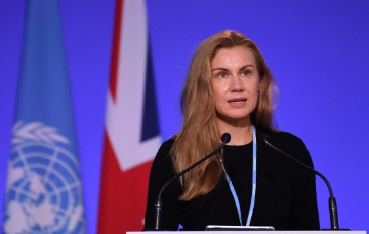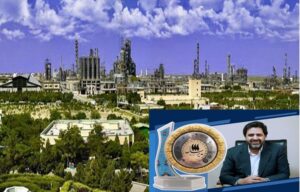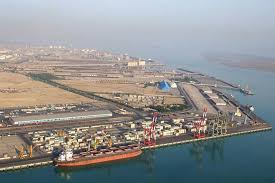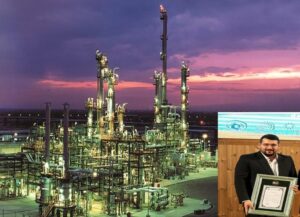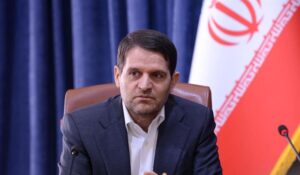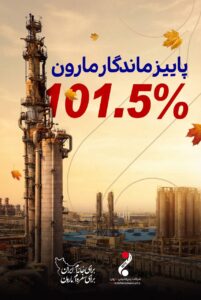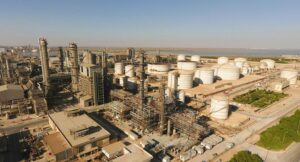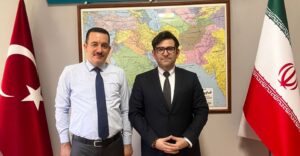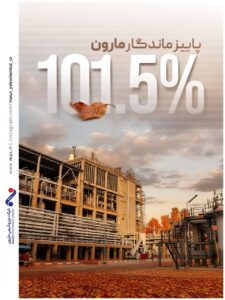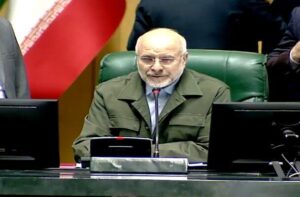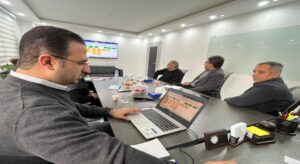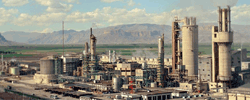:”Rahbord Energy“
Nikos Tsafos: Good morning. Good afternoon. Good evening. My name is Nikos Tsafos and I’m the James Schlesinger Chair for Energy and Geopolitics here at the Center for Strategic and International Studies.
And I’m so delighted to welcome today to CSIS the European Commissioner for Energy, Kadri Simson. Commissioner Simson is here for the meeting of the U.S.-EU Energy Council that happened yesterday with Secretaries Blinken, Granholm, and the EU High Representative, Josep Borrell. So we’re here to talk about that but also, of course, so many things happening on the topic of European Energy, both in terms of the current moment but also where Europe wants to go. So it’s great to have you here at CSIS.
One piece of logistics before we start our conversation. You’re watching this online, there’s a button for you to submit a question. Please do so. My colleagues will get those questions to me as we go along. I will do my best to integrate them into the conversation.
Commissioner, Simson, you’re here for the U.S.-EU Energy Council. Some of us may have read the statement that came out yesterday. One thing I noticed, it was a very long statement. So much to talk about, covered a lot of ground. What are your main takeaways from that conversation, where are the sort of highlight areas of collaboration, what was on the agenda, what did you take away from that conversation?
Kadri Simson: Good morning. And thank you for having me here.
Well, indeed the statement was long, because, well, we had quite a time to well-prepare that. It was first Energy Council – EU-U.S. Energy Council after three and a half years. So the previous one happened in the summer 2018. And right now the timing was excellent, but mainly we wanted to discuss our cooperation. We share the same values, and we share the same ambition to become climate neutral by 2050. So to achieve that, we need to, well, share best practices. And this was also the reason by some of our discussions dedicated to innovation and new technologies. We discussed how we can create a global hydrogen market. We discussed some new technological solutions that will help us on our path towards climate neutrality.
But because this energy council is not dedicated only to the, well, energy-related topics –there is me and my counterpart Jennifer Granholm, but also our top foreign affairs officials – then we had to discuss energy security, the current global tensions that are threatening not only Europe but also our neighborhood. And also discussed our joint effort to support Ukraine. For Europe, Ukraine has been a very trusted transit country. Just a couple of years ago we helped Ukraine to negotiate the next five-year term advanced contract with Gazprom. But now for us the high priority is to synchronize Ukraine’s electricity grid to European grid.
So all these workstreams were on our table. And what we agreed was that next year the next Energy Council will take place, so we don’t skip several years anymore. And of course, we will follow up this work at the high-level technical meetings.
Mr. Tsafos: Fantastic. No, and I really appreciated the amount of real estate you gave to the synchronization of the grids and to European integration with both the Baltics, the Ukraine, and the western Balkans. I think that’s great. And if we have time, I want to come back to some of the things you put on the table. But let me turn to the question that I think is on everyone’s mind for the moment. We’ve seen a period of very high energy, and particularly gas prices in Europe over the last six, seven months. Maybe we can start at what do you think is happening? What’s your diagnosis? How do you read the kind of events that we’re observing? And also, the European Union has put some things on the table late last year to try to address the current moment. Walk us through a little bit – first, when you see what’s happening, what do you think is causing it? And what is the commission doing sort of in the immediate – not the long-term transformation, but the immediate action that it can take?
Commissioner Simson: Well, that’s true, that we are witnessing extremely high energy prices right now. And this is creating problems for our industry and households. It started last autumn. And the main driver then was the fast recovery of world economy. So the driver was not EU market, but mainly Asia’s demand and their willingness to pay significantly higher margins for LNG cargoes than European traders were willing to pay. As a result, now the high energy prices are a matter of fact in place all across the globe. And for us, the heating season is peak season when we do consume gas, natural gas, so we had to adapt. And we proposed – we proposed several measures to help our consumers and our households.
Why the prices remain so high? There are also geopolitical tensions that create some anxiety in our gas market. We have seen that since the end of last year Russian shipments – pipeline gas shipments – have been significantly decreased and we have to replace it with LNG deliveries. We have done so, and in January the LNG shipments were at record high level for Europe.
And, of course, reactions toward these market signals have been also from consumption side. The power generation has replaced some of the natural gas with other alternatives. So what is good is that in December last year in Europe the renewables outcompeted fossil fuels. And in the regions where we do have more renewables in our energy mix, consumers can benefit. And they will have lower energy prices.
But there are, well, three concerns. One of those is affordability. We can lower taxes. We can support consumers with direct support schemes. Then there is a security-of-supply concern. This was also one of the topics that we discussed with our U.S. counterparts.
Mr. Tsafos: Can I – you know, there’s – when I look at what’s happening in Europe, obviously there is a need to, as you say, relieve the pressure from industries and from households to deal with the current crisis. But in some ways what happened over the last six, seven months also exposed, I think, some maybe more structural weaknesses in the European market. I mean, we had, you know, Gazprom, like, not filled storage, and it wasn’t clear that the EU regulatory system could do much about it besides observe that storage was not being filled. And we saw maybe other weaknesses as well.
You know, how do you think about addressing some of those kind of structural challenges? Again, not in the – we’ll talk about the EU framework about the gas market. We’ll talk about further down. But more in the sort of two- to five-year, like, do you see any kind of important interventions that at some point the commission talked about? I won’t call it – I think it was called investigation or something into the market mechanisms.
Walk us through some of those components that might sort of relieve the pressure from the type of weaknesses that we saw these past seven, eight months.
Commissioner Simson: Yes. Well, indeed, what we see right now is a gas-market crisis. This is not result of our clean transition. On the contrary, we see that clean transition is a part of our – is a solution for our problems.
Right now, despite all the efforts to diversify our energy mix, to diversify supply routes for natural gas and suppliers, we’re still very dependent on import of fossil fuels. So 90 percent of fossil gas that we consume is imported, even worse on crude-oil consumption. And at the same time, compared to the previous crisis that we had more than a decade ago, we have invested a lot into the infrastructure. All across Europe we do have now LNG terminals. This is commodity that you can trade freely, and it gives us some flexibility. It has helped already us to compensate the decrease of pipeline flows from major supplier, from Russia. And we have also invested a lot into the interconnectors between our member states.
So preparing now our contingency plans and preparing different scenarios. If there will be a real disruption – partial or full disruption – from pipeline flows from Russia, we have identified alternative routes and, of course, there is a possibility to introduce reverse flows. For example, this is already ongoing since 21st of December when flows from the Yamal pipeline. That means Russia – Russia’s deliveries through Belarus to Poland have been stopped and now Poland is served by Germany using reverse flows.
So this is a good example how we shouldn’t waste a good crisis, and Europe has acted since the previous crisis. So now there is a question that are there sufficient alternatives – supplies available at the global scale. So this is what I am doing. I’m following our president’s calls.
So already last autumn we reached out to Qatar and Norway, who both are good and reliable partners. I just came here from Azerbaijan because this is the year when Azeri pipeline will reach the maximum capacity. And of course, United States has helped us a lot. Since December and January, we have received lots of LNG cargoes that helped us to replace the missing pipeline volumes.
Mr. Tsafos: Absolutely, the U.S. LNG being the top supplier into Europe in January, quite a – quite a turn. And I also appreciate what you said. I think sometimes in Washington there’s a sense that the crisis happened in 2006 and 2009 and Europe did nothing. So I really appreciate you articulating all the different ways in which European energy security has been enhanced.
Let me turn a little bit more into the future and the transformation of the European energy system. In December, the commission put out a sort of new framework for methane, for gas markets, for hydrogen. It was – you know, the EU Green Deal is a marathon, right. So it’s never – I’m never quite sure what milestone we’re at. A new thing comes and then a new thing comes. But walk us through what happened in December. What did that framework entail? How important is it? What was in it and what are you hoping to accomplish with that?
Commissioner Simson: Well, recall this December package as a second part of Fit for 55 packages. So my colleagues are telling me that this was the biggest package of proposals that the commission has ever proposed. These legislative proposals are very interlinked, and there will be a great challenge now ahead of us to negotiate with all our member states and European parliament.
There will be different formations of ministers, different formations from committees of the parliament negotiating these pieces. When, in the summer of last year, we proposed to raise our targets for renewables and energy efficiency so that it will be possible to cut our greenhouse gas emissions by at least 55 percent by 2030, then – now we addressed maybe more complicated sectors. Gas is definitely one of those. We know that we’ll need natural gas as a fuel during our transition period.
But we have to start decarbonizing our gas market, and that’s why one of the main aims of this decarbonized gas market and hydrogen proposal was to open access for clean gases but also to create a framework for hydrogen because we don’t have EU wide hydrogen market right now. But we hope that by 2030 we will have a well-functioning hydrogen market.
And then on top of that we strengthened the security of supply aspect because of current tensions. And then, as a first region, we followed up the Global Methane Pledge. I think that that was a very good example how European Union and United States can work together, how we attracted so many partners to become signatories of Global Methane Pledge. And, well, you can lead by example.
So we will – we will address with our legislation EU methane emissions in the coal sector and also gas and oil sector, and then we will promote the global approach under the International Methane Emissions Observatory. And the third part of this December package was dedicated to our buildings, because what we see right now, well, 22 percent of our gas consumption goes to heating. So if you insulate your houses, you can also cut dependency that we do have in this – in this sector.
Mr. Tsafos: Well, thank you. As you said, it’s a – it’s a big package. You put a couple things on the table that if we have time I would like to go back to, both the methane and the – and the clean gases and hydrogen.
But let me take you to another corner of the conversation for a second, and that is sort of finance and investment. And I would like to hear your thoughts on both the mobilization of finance within the European Union but also, you know, COP-26 wasn’t that long ago – (laughs) – even though we’ve been sort of consumed by this current crisis. The question of how do we make enough capital available to emerging economies to meet their commitments continues to come up. So maybe we could walk us through both the sort of intra-European conversation as well as the sort of European contribution to this global target that we have to increase the flow of capital to countries that need it to meet their goals.
Commissioner Simson: Well, we really think that this is important, to help emerging economies to decarbonize their, well, energy portfolio too. And in this regard, Europe has been a major contributor to global financing.
Well, last September, before the COP, our president, Ursula von der Leyen, announced that on top of already – well, already 23 billion euros that we have provided for global financing, we will add 4 more billions so that it will trigger the action from other partners. So this is a priority for us even at the moment where energy prices are creating trouble back home. For example, this afternoon I’m leaving from here to Dakar, Senegal, to go where the African Union’s presidency, and we will have a visit together with our president, Ursula von der Leyen, there, because, well, we have to promote sustainable development also in Africa.
Coming back to home, well, what we can do in the European Union, well, we do have a clear understanding that we can support some projects with our public financing. And we just agreed with a long-term funding at the EU level, and then to support the recovery we also added recovery funds. So member states have to dedicate 37 percent of their expenditure to the climate-related projects.
There are different workstreams. Well, renovation is one of those, but of course lots of renewable projects, starting from offshore wind and solar and, of course, hydrogen, which is a new, attractive fuel for industry and transport. But we need private investments to achieve our target.
So, in this regard, the taxonomy – well, EU taxonomy should help us to guide private investors to oversee investments that we regard as sustainable. There was first act on taxonomy last year that covered all the renewables. And now just a week ago we proposed another Delegated Act that covers the fuels that we will need to transition. Among them that is natural gas and investments into new nuclear.
Mr. Tsafos: Sometimes this town follows the conversation on European taxonomy like it’s a soap opera. You know, we’re waiting for the new episode. You mentioned the new Delegated Act. Can I maybe get you to say a few more words about where we are? Is this – is this the end of the conversation, that this is essentially the consensus, this is the agreement? Should we expect some more iterations to come? The language essentially was on nuclear and gas that sort of gave some very specific conditions under which those solutions could be sort of given the label. Is this the end, or should we be expecting more? Obviously, it’s a never-ending sort of dialogue in Europe, but in terms of this particular act?
Commissioner Simson: Well, this particular act should come into force from 1st of January 2023, if we will get support from member states and European Parliament. So they have a right either to reject or then support this act, without any amendments. And their discussions will be – will be heated because, well, nuclear is a topic where member states and politicians do have very different views. So we do have member states who have announced that they will close down nuclear power plants. We do have member states who have never built any nuclear power plants at all. And then we have member states who are right now planning new – the buildup of new reactors. So lots of – lots of discussions in this field, but based on our treaty every member state can choose solely their energy mix.
And on natural gas, we will promote these investments, which help us to phase out coal and replace it with natural gas. So switch from coal to gas actually cuts greenhouse gas emissions significantly. And this was a process that helped us to achieve our 2020 targets. Right now, gas is significantly more expensive than locally produced coal. But because in Europe carbon has a price, then overall the switch should continue to happen in the decades to come.
Mr. Tsafos: No, thank you for that. And I have to say, as someone who lives in Washington observing the conversation, sometimes, you know, it looks sometimes messy, because democracy is messy. But I always appreciate the search for solution rather than letting the disagreement produce gridlock and no decision. So I appreciate that a lot.
You’ve mentioned a few things that I hope we have time to come back on but let me ask one more thing that was also in the statement yesterday of the council. And that the question of ensuring a just transition. And I – and I saw that the wording in the statement yesterday also had sort of energy poverty there, which obviously is a topic that is much more acute today with energy prices. From the beginning, the EU Green Deal has had a focus on making sure that this is a just transition. Maybe let’s start there. Where are you in that process? You’ve had a lot of initiatives in specific countries. You’re also doing some work outside of the union to help countries implement a just transition. And maybe as you walk us through the agenda, you know, this country is also grappling with some very similar questions with environmental justice and just transition. So if you had a word or two about the transatlantic element of that collaboration, I think our audience would be very interested in that too.
Commissioner Simson: Yes. We have a strong belief that this transition has to be fair or it doesn’t happen. And we’ve promoted the approach that these regions, who have worse starting position, should be treated fairly. And over two years ago, we created just-transition mechanism that gives us extra support to regions that are, until now, dependent on fossil mining activities. And with this additional financing, we hope that we can replace these jobs that will be lost because of mining activity will cease to exist with clean jobs.
We all know that renewables will create lots of new job opportunities. But unless we are delivering dedicated support to these regions, the new jobs might be created in absolutely different geographic locations. So we don’t want to end up in the situation where people will lose their jobs and are forced to leave their neighborhood to find new jobs somewhere else.
The same principle is important all across the globe. We do have similar just-transition projects covering also Western Balkans and Ukraine. And now globally the first big announcement was also made public during COP26 when several major – well, several governments announced that they will dedicate more than 8 billion euros to the just-transition program in South Africa. So this is a country which is very dependent on coal mining and who are actually interested to promote clean alternatives. So I think that fairness is a principle that we have to, well, honor in this regard.
Mr. Tsafos: Well, thank you for saying that. And South Africa is also a country that we here at CSIS have studied extensively. And so when we saw that announcement at COP, I think it was very much in line with the type of international support that we hope to see for South Africa.
You mentioned in passing carbon pricing. And, you know, we’ve seen, you know, for anyone who’s been in the energy sector for a while, you know, European carbon prices spent, you know, about a decade at extremely low levels. They were just kind of there in the corner. And over the last sort of, you know, year, year plus, we’ve seen just an incredible increase in the carbon price in Europe.
You know, is that something that worries you, or do you see that as part of a necessary component of the market functioning? And what should we expect on the future of carbon pricing? Obviously, it’s one element of a much broader package for Europe in terms of the transition. But what should we be expecting in terms of, like, the next phases of, you know, the ETS and the carbon-pricing system in Europe?
Commissioner Simson: Well, when this system was created in Europe, the negotiators also planned an emergency mechanism. And prices increased very rapidly. That is happening right now. So I think that yesterday we witnessed another record-high price level. And, of course, several member states, especially the ones who are still using coal, are extremely worried because of this tendency. And, well, extending this carbon pricing to the buildings and transport sector is under negotiations right now.
So we have to, well, offer to the industry some predictability. But definitely this pricing scheme has been useful to guide industry towards cleaner solutions. And, well, in the medium and long run these regions who cover most of their energy consumption with clean alternatives will benefit.
On carbon pricing, despite the fact that it has reached record high levels in Europe, it has not avoided the situation where, during this heating season, we do consume more coal to replace the missing gas flows. And this has been also one of the drivers that is behind this high CO2 emission level that industry has to buy additional quotas, because everybody knows that coal emits more CO2 than gas. But unfortunately, this is one of the results how our market reacts to the deficit that is there right now in the gas market.
Mr. Tsafos: Thank you. Thank you for that.
We only have a few more minutes to go, but I wanted to see if I could get maybe just a few words on two sort of particular technologies that you’ve mentioned, if I could get a few more words out of you. One, on hydrogen, particularly, the sort of rules and codes and standards side of things, what the European Union is doing and how can collaboration with the United States be enhanced in that area.
And the second technology is offshore wind. This administration has incredibly high ambitions for offshore wind, but the deployment has been much slower than in Europe. Where do you see areas for possible collaboration on offshore wind in terms of, you know, bringing some of the lessons from a region of the world, Europe, that has deployed a lot of offshore wind?
On the hydrogen side, a little bit more, maybe, on the standards and codes and technical requirements for this market.
Commissioner Simson: I will actually return after two month(s) because we will have business-to-business event on offshore wind in New Jersey. So this is one of the technologies that we are really interested to promote from our perspective.
Well, we are negotiating with our member states that they should achieve the level of 40 percent of energy consumption will be covered with renewables. And from there, when you get those renewables, of course, there is also program for permitting in Europe. We see that vast – that offshore wind has vast potential, and not only bottom-fixed offshore because we do have sea spaces where we do have shallow coastal waters but then we have Atlantic and we have Mediterranean, and there they could use alternative solutions like floating offshore or there is lots of projects ongoing to get out of piloting phase on tidal and wave energy. And this is – this is an interesting workstream where Europe still holds the global leadership, but we are really interested to share our best practices.
And from our side, we will also guide our member states how to, well, fasten the permitting procedures. Because if we want to scale up the production of offshore wind parks, we have to, well, fasten this procedure.
And on hydrogen, well, this is not – well, this is emerging market. And at the same time, we do know that in Europe industry already, well, needs hydrogen, but the 98 percent of hydrogen that we consume right now is gray hydrogen so without any carbon capture, not coming from renewables via electrolyzers. So we will promote renewable hydrogen, but to replace the gray hydrogen, the fossil hydrogen, we will also need so-called blue hydrogen. And to incentivize investments into this sector, we also propose that by – well, soon our industry and some modes of transport should use certain volumes of hydrogen to replace fossil fuels.
Mr. Tsafos: Well, thank you for those closing comments on hydrogen and offshore wind, two of the most exciting areas where things are happening in both Europe and the United States.
We’ve come up to our time, and so I just wanted to thank you for being here at CSIS and having these conversations with us. But also, of course, thank you for your leadership. You know, when I think about what we need to do to meet our climate goals, the U.S.-EU partnership is probably one of the most important in terms of meeting that very ambitious agenda. So thank you for all the work that you and your team do in helping us to get there.
And with that, thank you very much for tuning in. Until next time.

